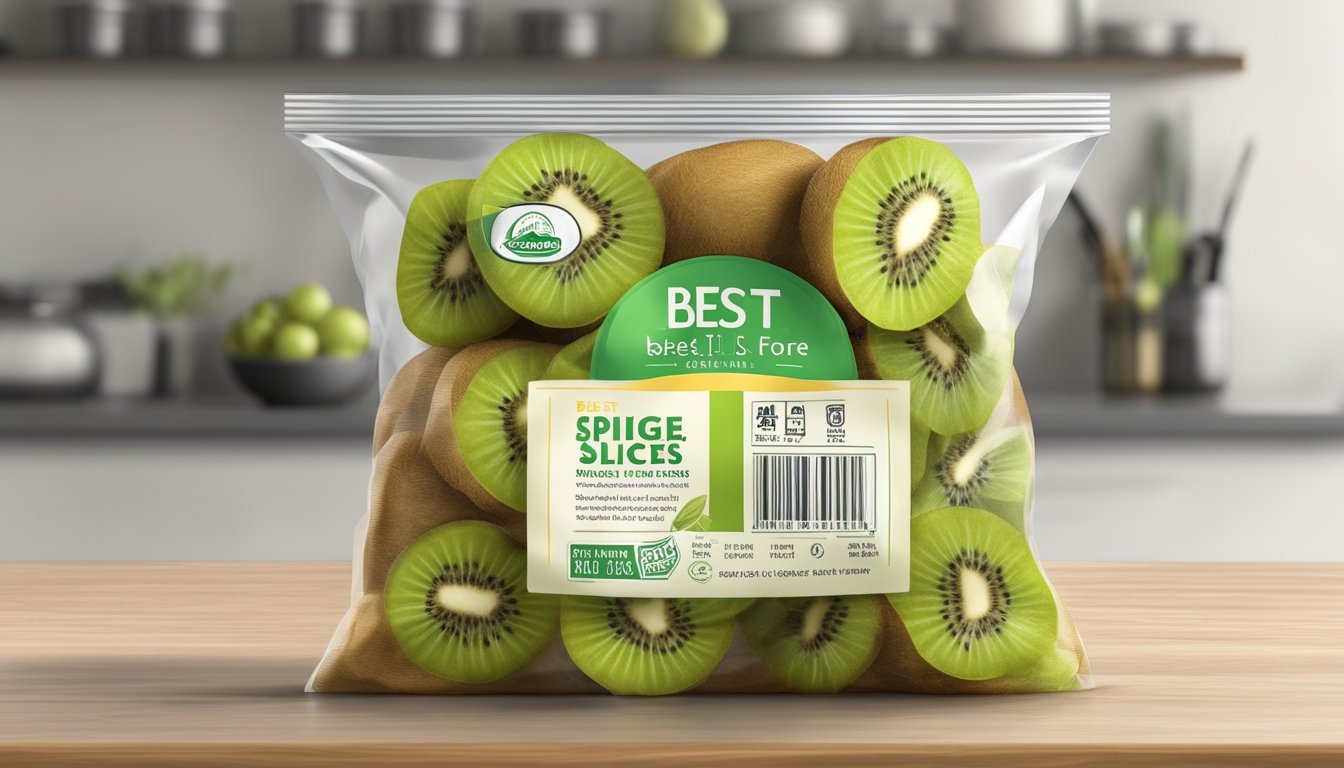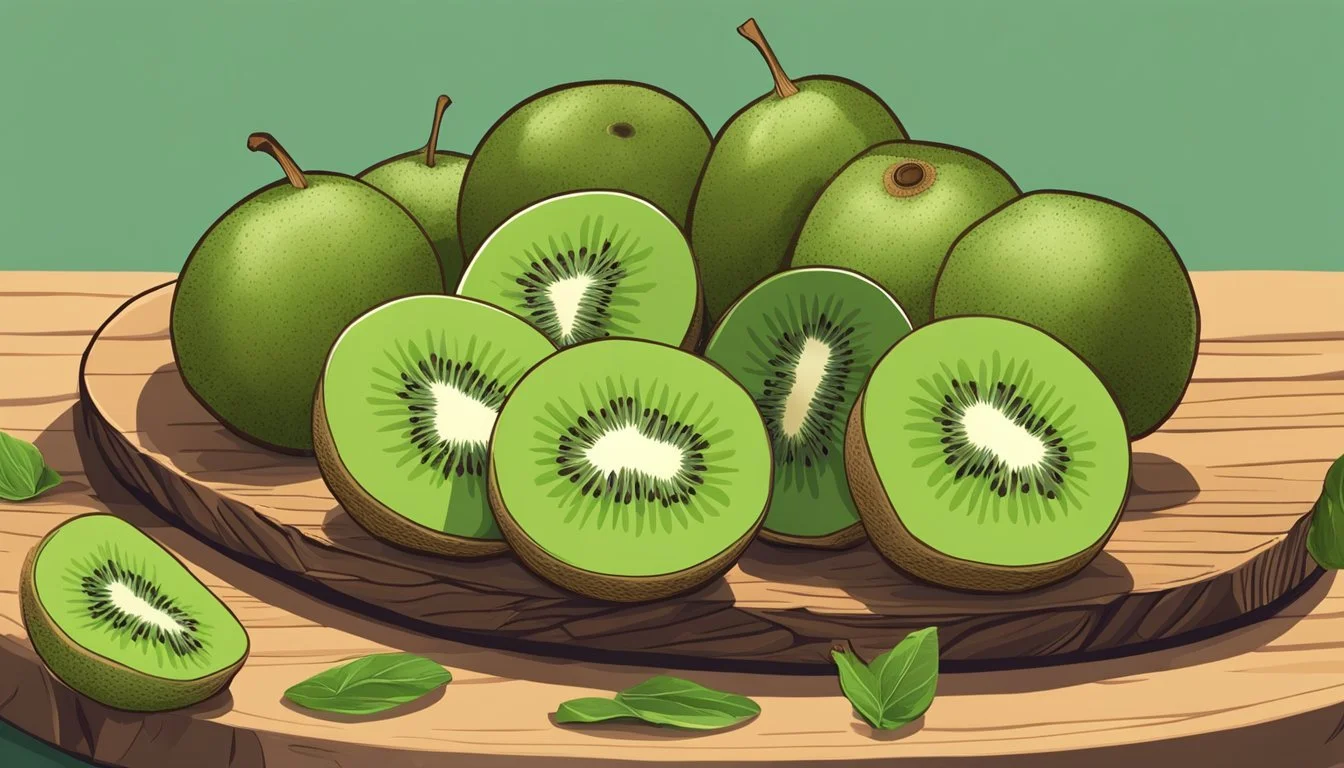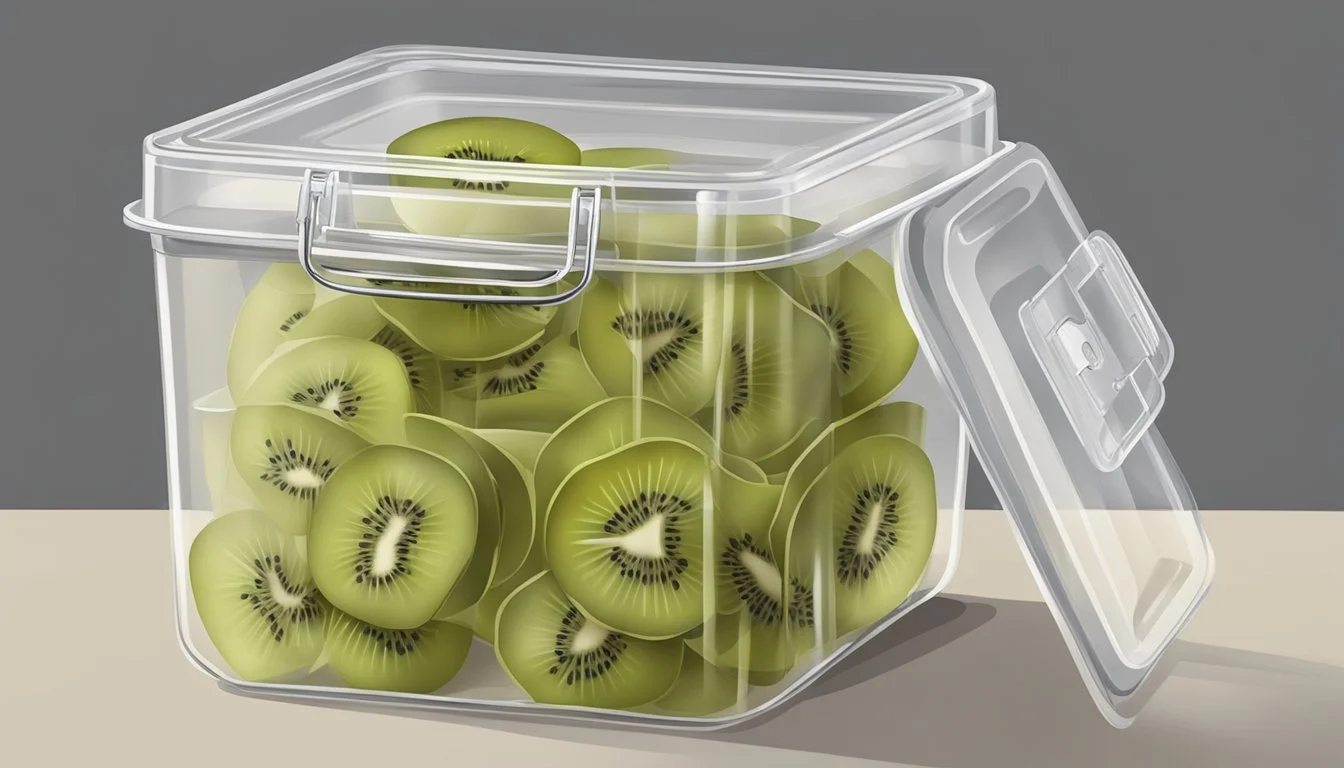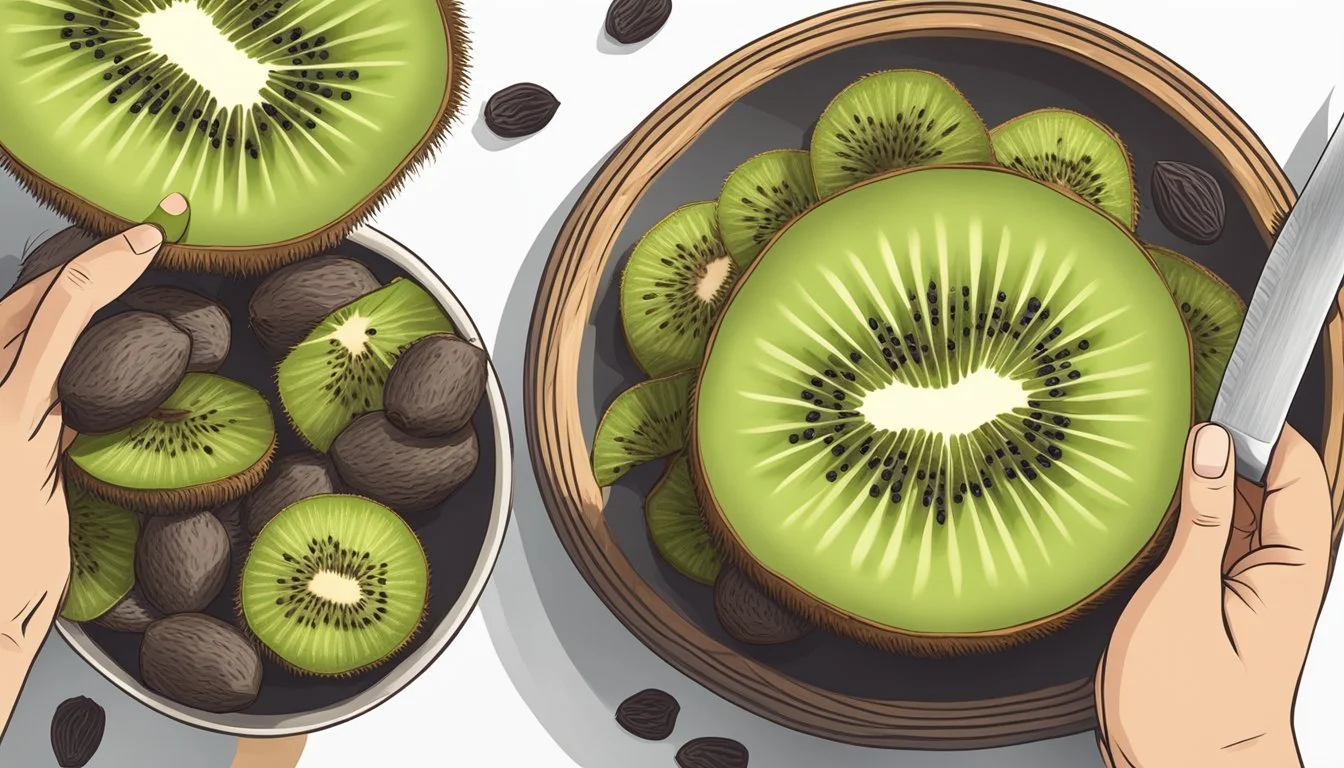How Long Do Dried Kiwi Slices Last?
Uncovering Their Shelf Life
Dried kiwi slices offer a nutritious and flavorful snack that retains much of the fruit's original vitamin and mineral content. The drying process removes water from the kiwi, concentrating its natural sugars (how long does sugar last?) and nutrients, making it a healthy alternative to candies and other sweet treats. The shelf life of dried kiwi depends on several factors, including the drying method, storage conditions, and whether they have been commercially processed or prepared at home.
Kiwi slices are best dried when they reach a leathery yet pliable texture. When stored properly in a cool, dry, and dark place, dried kiwi slices can last from 4 months to 1 year. Proper storage in an airtight container with a moisture absorber is key to extending their shelf life and preserving their taste and nutritional quality. If the dried kiwi slices are conditioned to an appropriate moisture content, they can remain a delicious and healthy snack all year round.
Understanding Dried Kiwi
Dried kiwi slices are a popular, nutritious snack that maintains much of the fruit's nutritional value while offering a longer shelf life. This section explores their nutritional benefits, how they are created, and what preparation methods are ideal for superior quality.
Nutritional Profile
Dried kiwi is a healthy snack option rich in vital nutrients. Each serving provides a considerable amount of fiber, aiding in digestion, and is an excellent source of vitamin C, which supports the immune system. Kiwi slices are also packed with potassium, important for heart health, as well as antioxidants that protect the body against free radicals. They contain a balance of calories, protein, carbohydrates, and a low amount of fat.
Nutrient Per Serving Calories Varied Protein Varied Carbohydrates Varied Fat Low Fiber High Potassium High Vitamin C High Antioxidants Present
Dehydrating Process
Drying or dehydrating kiwi involves removing moisture to extend its shelf life and concentrate its flavors. The process can be done using an oven, air fryer, or a dehydrator. For even drying, slices should be placed in single layers on the dehydrator trays. The optimal temperature is around 135°F (57°C), and the drying time may range from 6 to 12 hours, depending on slice thickness and moisture content.
The Role of Preparation
The preparation of kiwi before dehydrating is crucial for ensuring quality and even drying. Kiwi should be peeled using a vegetable peeler or paring knife. Following peeling, kiwi are sliced uniformly, typically with a knife or mandoline to ensure even thickness. Well-prepared kiwi will result in a leathery texture when dehydrated, a sign of proper drying. Proper preparation leads to a better-textured snack and a consistent drying process.
Storing Dried Kiwi
Proper storage is crucial for maximizing the shelf life of dried kiwi slices. Ensuring the right conditions will keep them flavorful and prevent spoilage.
Ideal Conditions for Storage
When storing dried kiwi, one must focus on maintaining a balance of temperature, humidity, and light exposure. Containers should be airtight to prevent moisture from seeping in, which can lead to mold growth and spoilage. A cool, dark place, such as a pantry or cupboard away from direct sunlight, is ideal for preserving the quality of dried kiwi. The best temperature for storage is usually around 60°F (15°C) or below.
Temperature: Keep at or below 60°F (15°C)
Light: Store in a dark place
Ambient humidity: Low; use moisture absorbers if necessary
Container: Airtight jars or containers
Long-Term Preservation
For those looking to extend the shelf life of dried kiwi beyond the typical 4 months to 1 year, additional measures can be taken. Vacuum-sealing the kiwi slices removes air, further minimizing the risk of moisture and oxidation. If vacuum-sealing isn't an option, including a moisture absorber in the storage container can help. For the longest possible preservation, one can store the airtight and vacuum-sealed kiwis in the freezer, extending their shelf life significantly.
Packaging: Vacuum-sealed bags are optimal
Additional Protection: Moisture absorbers in containers
Freezer Storage: An option for extending shelf life greatly
Shelf Life of Dried Kiwi
Dried kiwi slices are a popular snack, lauded for their prolonged shelf life compared to their fresh counterparts. The longevity of dried kiwi heavily relies on storage conditions and packaging quality.
Storage Conditions:
Optimal storage: A cool, dry, dark place—such as a pantry or cupboard—is recommended.
Temperature: A stable, moderate temperature helps prevent spoilage.
Humidity: Low humidity levels are crucial to extend the shelf life of dried kiwi.
Expected Shelf Life: Dried kiwi typically retains quality for:
Unopened package: Up to 12 months.
After opening: Best consumed within 6 to 8 months for optimal freshness.
Packaging After Opening:
An airtight container or a heavy-duty plastic bag is essential to maintain the quality.
Oxygen absorbers within containers can further safeguard the fruit from spoilage.
Quality Indicators:
Texture: The slices should stay chewy and slightly leathery.
Color: There should be minimal discoloration, with slices maintaining their vibrant green hue.
Smell: The characteristic fruity scent should remain without any off odors.
Freshness: A lack of moisture is key, as it prevents microbial growth and retains the fruit's freshness.
By adhering to these guidelines, consumers can enjoy dried kiwi well beyond the season of fresh kiwi, with minimal loss in quality and enjoyment. However, one must be vigilant and check for any signs of spoilage over time.
Common Issues with Storage
When storing dried kiwi slices, maintaining their quality depends on preventing moisture exposure and avoiding spoilage. Improper storage can compromise the dried fruit's flavor and safety.
Preventing Moisture and Mold
Dried kiwi slices are highly susceptible to mold growth when exposed to moisture and humidity. Storing them in airtight containers is essential to create a barrier against environmental humidity. It is recommended to pack dried kiwi in dry, scalded glass jars or airtight freezer containers to protect them from moisture. For added safety, include desiccant packets to absorb any excess moisture.
One must ensure the storage area is cool and away from direct light as both heat and light can increase the risk of moisture build-up, even in airtight conditions. This is because heat can cause condensation inside containers when there are temperature fluctuations, introducing water into the dry environment.
Avoiding Spoilage
The shelf life of dried kiwi slices is also dependent on maintaining proper temperature conditions. Storing the fruit at a consistent temperature of 0°F if frozen, or in a cool, dark place if at room temperature, helps preserve quality and extend longevity. Dried kiwi can generally last for about 12 to 18 months when stored correctly, but it's best consumed within six months to a year for optimal taste and texture.
One must keep the slices away from strong-smelling foods or contaminants as dried kiwi can absorb odors, which could lead to spoilage or an unpleasant taste. Regularly checking the condition of the stored fruit for any signs of spoilage, like discoloration or off-odors, helps in early detection and prevention of potential health issues from consuming spoiled dried kiwi.
Using Dried Kiwi in Recipes
Dried kiwi slices are a versatile ingredient that can enhance a variety of recipes with their tangy sweetness. They are often used to add a chewy texture and a burst of flavor to healthy snacks and baked goods.
Healthy Snacking Options
For those wanting nutritious and delightful snacking alternatives, dried kiwi slices fit the bill. They can be enjoyed on their own or incorporated into various snacks:
Trail Mix: Combine them with nuts, seeds, and a sprinkle of chocolate chips to create a trail mix.
Yogurt Topping: Add dried kiwi to Greek yogurt for a balance of tartness and creamy sweetness.
Granola: Mix into homemade granola for a chewy, tangy twist.
Cooking and Baking
Dried kiwi can also contribute a special flavor and texture to cooking and baking:
Baked Goods: Incorporate them into muffins, cookies, or fruit bread for a vibrant, fruity note.
Candy: Create homemade kiwi-flavored candies by incorporating finely chopped dried kiwi.
Smoothies: Blend into smoothies for an extra dose of sweet tanginess and fiber.
Each use of dried kiwi in recipes offers a sweet yet healthy component that adds both taste and nutrition to everyday dishes.
Alternative Drying Methods
When preserving the freshness and flavor of kiwi fruit, two practical techniques are drying kiwis in an oven or air fryer, and utilizing everyday equipment found in a typical kitchen.
Using an Oven or Air Fryer
An oven or air fryer offers a controlled drying environment. Home preservers will need:
Cookie sheets
Parchment paper
Knife
To dry kiwi in an oven, one should:
Preheat the oven to a low temperature, typically around 135ºF, to maintain a cool environment that preserves the fruit's nutrients.
Peel the kiwis with a knife and slice them uniformly to ensure even drying.
Place the slices on a cookie sheet lined with parchment paper, keeping them spaced apart to promote airflow.
Allow the kiwi to dehydrate until they are fully dry, which can take between 6 to 12 hours.
Using an air fryer follows a similar process:
Preheat the air fryer to around 130°F to minimize the risk of overheating.
Arrange the kiwi slices in a single layer in the air fryer basket, ensuring space between them.
The drying time is typically shorter, approximately four hours, but varies depending on the exact model and thickness of the slices.
Dry Kiwi Without Special Equipment
For those who do not possess an oven or air fryer, kiwi fruit can still be dried using no specialized equipment by harnessing the natural heat from the sun:
The process requires a warm, dry day and safe outdoor space.
Slices should be thinly cut using a knife and placed on trays that allow air circulation.
Covering with a fine mesh can protect against insects while the kiwi slices cool down and dehydrate under the sun.
This process of sun-drying requires several days and consistent sun exposure, with the kiwi needing to be brought indoors at night to prevent moisture from setting in. It's essential to monitor the texture and dryness to ensure the kiwi slices do not spoil before they are fully preserved.
Tips for Selecting and Preparing Kiwi
Selecting the right kiwi fruit and understanding the pretreatment methods are vital for creating quality dried kiwi slices that are both delicious and long-lasting.
Choosing the Right Kiwi Fruit
When one is preparing to dehydrate kiwi, selecting ripe kiwis is essential. A ripe kiwi should yield slightly to gentle pressure but should not be too soft or squishy. The skin color doesn't necessarily indicate ripeness, so rely on the feel. The variety of kiwi also matters; some are sweeter and more suitable for drying than others. A fresh kiwi should be washed thoroughly under running water before any prep work begins.
Pretreatment Methods
Before dehydrating, pretreating the kiwi can improve both flavor and shelf-life. Here are suggested pretreatment methods:
Peel: Remove the kiwi's fuzzy skin using a peeler or by slicing in half and scooping the flesh out with a spoon. While the skin is edible, peeling it off provides a better texture for dried fruit.
Slice: Cut the kiwi into uniform 1/4" thick slices to ensure even drying.
Dip in Sugar Solution: A light coating of sugar syrup can be used to reduce browning and add a little extra sweetness. However, it's important to note that adding sugar will increase the final sugar content of the dried fruit.
Pretreatment Step Description Wash Clean fresh kiwi under running water to remove impurities. Peel Use a peeler or spoon to remove the skin for better texture. Slice Cut into even 1/4" slices for uniform drying. Sugar Dip Optional: Dip slices in sugar syrup to enhance sweetness and color.
After pretreatment, the kiwi slices are ready to be dehydrated, which typically takes around 6 to 12 hours at 135ºF until they achieve a leathery and dry yet pliable consistency.
Health Benefits of Dried Kiwi
Dried kiwi is a nutrient-dense snack that offers various health benefits due to its concentration of vitamins, minerals, fiber, and antioxidants.
Vitamins: They are an excellent source of Vitamin C, key to supporting the immune system, and Vitamin K, which plays a role in blood clotting and bone metabolism.
Fiber: The fruit is high in dietary fiber, which aids in digestion and promotes a feeling of fullness, potentially supporting weight management efforts.
Potassium: Potassium is abundant in kiwis and helps maintain fluid balance, nerve function, and muscle contractions.
Antioxidants: With a rich content of antioxidants such as vitamin E and polyphenols, dried kiwis can counteract oxidative stress and may reduce the risk of chronic diseases.
Consuming dried kiwi can be a part of a healthy diet, providing essential nutrients that may be lacking in other snacks. Its low-calorie, high-fiber makeup can be particularly beneficial for those looking to maintain a balanced diet. However, portion control is important, as dried fruits (What wine goes well with dried fruits?) are more calorie-dense than their fresh counterparts due to the removal of water content.
Incorporating dried kiwi into one's diet can contribute to the overall intake of nutrients necessary for optimal health, making it a smart and tasty choice for individuals aiming to enhance their dietary pattern.
Innovative Uses of Dried Kiwi
Dried kiwi slices are not only a delectable treat but also a versatile ingredient in the culinary world. Their bright color and tangy-sweet flavor make them suitable for a variety of innovative uses.
Dried Kiwi as a Decorative Topping
Dried kiwi can add a vibrant touch and a burst of flavor to various dishes.
Desserts: One can garnish cakes, especially Kiwi Upside Down Cake, with these sweet slices to enhance visual appeal and taste.
Breakfast bowls: Adding them atop a bowl of yogurt or oatmeal imparts a lively contrast and enriches the meal with its fruity essence.
This healthy addition can transform the mundane into visually appealing and flavor-packed meals.
Creative Snacking Ideas
In terms of snacking, dried kiwi offers a nutritious alternative to sugary options, packed with vitamins and fiber.
Kiwi Chips: Ideal for on-the-go snacking, kiwi chips retain the natural sweetness and tartness of the fruit.
Trail Mix: Incorporate dried kiwi into a trail mix with nuts and other dried fruits for a tropical twist.
Kiwi Granola: They can be mixed into granola recipes for an extra punch of flavor and color.
Each of these recipes capitalizes on the distinctive taste of kiwi to elevate the snacking experience. The chewy texture and sweet-tangy profile of dried kiwi meld well with other snack components to create harmony in every bite.
Considerations for Diets and Allergies
When incorporating dried kiwi slices into a diet, individuals should be aware of their nutritional content and potential allergenic properties. Dried kiwi is a calorie-dense food with a high sugar content, which can impact dietary goals. A good source of dietary fiber, dried kiwi contributes to digestive health.
Nutritional Content of Dried Kiwi:
Calories: Higher than fresh kiwi due to dehydration concentration.
Sugar: Contains natural sugars; pay attention to added sugars in some commercial preparations.
Fiber: Valuable for maintaining bowel health.
For those with allergies, kiwi may trigger adverse reactions, ranging from mild oral discomfort to severe systemic symptoms. People prone to food allergies should consult a health professional for personalized advice.
Common Allergic Reactions:
Itchy, tingly mouth
Stomach pains
Skin rash
Respiratory distress
If one exhibits allergic symptoms after consuming kiwi, they should seek medical attention. Those with a known kiwi allergy should diligently check food labels, as kiwi can be present in various dried fruit mixes.
Recommendations for Allergy Sufferers:
Always read ingredient labels.
Be cautious of cross-contamination.
Have an allergy action plan.
Individuals managing their diet for health or personal preference should consider the nutritional benefits and allergy risks of dried kiwi slices. As with all foods, moderation is key.
Packaging and Presentation
When it comes to the longevity of dried kiwi slices, packaging plays a critical role. Dried kiwis should ideally be stored in airtight containers. If the original packaging is not resealable, transferring the slices to a container with an airtight seal can considerably extend their shelf life.
Thickness of the slices also contributes to their preservation. Thicker slices may be more pliable and retain moisture, which can shorten their storage life. Conversely, thinner slices dehydrate more thoroughly, resulting in a product that may break easily but also lasts longer under proper storage conditions.
For consumers, the visual appeal of packaging can also affect the purchase decision. Hence, retailers frequently use clear containers or bags that showcase the enticing, vibrant green color of the kiwi. This practice not only aids marketing but allows for a quick visual inspection of the product quality.
Proper Presentation:
Containers:
Clear packaging for visual inspection
Airtight seals to preserve freshness
Resealable for maintaining quality after opening
Kiwi Slice Thickness:
Uniform slicing for even drying and storage stability
Consideration of slice size for texture preference (pliable vs. brittle)
When selecting dried kiwi slices, it is advisable for customers to consider these packaging and presentation factors to ensure they enjoy their dried fruit in the best possible condition over time.
Outdoor Activities and Dried Kiwi
Dried kiwi slices offer a convenient and nutritious option for outdoor enthusiasts looking for a lightweight and energy-boosting snack.
Dried Kiwi for Hiking and Backpacking
Hikers and backpackers often favor foods that are light to carry, easy to preserve, and nutritious. Dried kiwi ticks all these boxes and is a popular choice for trails. Its sweet yet tangy flavor and chewy texture make it an enjoyable snack.
Weight and Space: Dried kiwi is lightweight and compact, which helps minimize the load and makes it easy to pack in tight spots.
Nutritional Value: Rich in vitamins and minerals, dried kiwi provides necessary nutrients without adding significant weight.
Energy Boost: With natural sugars and fiber, they offer a quick energy lift that can be crucial during long treks.
Preservation: Properly dried and stored kiwi can preserve well, making it suitable for extended trips without the need for refrigeration.
For outdoor activities, individuals often incorporate dried kiwi into trail mix, combining it with nuts and seeds to enhance the taste and nutritional profile. Dried kiwi is not only a delightful snack on its own but also complements other foods well, which is why it's a staple in many hikers' packs.













